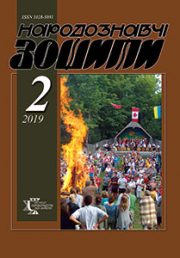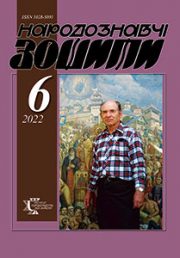The Ethnology Notebooks. 2021. № 3 (159), 675—688
UDK [7.046.02:271-526.62-312.47](477.83)
DOI https://doi.org/10.15407/nz2021.03.675
FEDAK Marta
- ORCID ID: https://orcid.org/0000-0002-8836-8955
- fellow researcher of the Ethnology Institute
- of the National Academy of Science of Ukraine,
- junior researcher,
- National Museum in Lviv named after Andrey Sheptytsky
- 20, Svobody av., 79008, Lviv, Ukraine,
- Contacts: e-mail: marta_fedak@yahoo.com
Abstract. Introduction. The works of the third quarter of the 16th century of the tentatively named master of the icon Lord’s Transfiguration from the Church of the Annunciation of the Theotokos from Yabluniv, Turka District in Lviv Region, are considered. These paintings mark the origins of one of the largest painting centers, whose activities can be traced back to the second half of 16th — early 17th centuries. These examples, for the first time in the Ukrainian iconpainting, represent the reproduction of the landscape as an authentic reality, as well as the introduction of drapery ornamentation, which associatively resonates with folk embroidery.
Problem Statement. These paintings have not yet been the focus of a separate research where they would be structured according to the painting style of the anonymous master of Yabluniv’s Lord’s Transfiguration. Some of them have not been attributed and put into scientific circulation yet.
The Purpose of the article is to systematize the paintings that correspond to the style of the master of the icon Lord’s Transfiguration from Yabluniv. Consider their artistic features and iconography, as well as specify the date. The methods used for this purpose include formal analysis, cultural context and reconstruction. The methods of iconography and iconology are used to trace the peculiarities of the interpretation of plots. The object of research is the icons, the Royal Door and book miniature paintings marked by the painting style of the master of the icon Lord’s Transfiguration from Yabluniv. The subject of research is the artistic, stylistic and iconographic characteristics of the paintings.
Results. Twenty one paintings have been identified according to a number of artistic and stylistic characteristics that belong to the creative heritage of the master of the icon Lord’s Transfiguration from Yabluniv.
Conclusion. The iconographic paintings of the tentatively named anonymous master of the icon Lord’s Transfiguration from Yabluniv should be dated back to the third quarter of the 16th century. The painting style of the works identifies the master with professional training whose paintings remain faithful to the Byzantine traditions with a courageous implementation of realistic tendencies based on national culture. Relatively speaking, a new artistic era in the Ukrainian painting in its final period under the aegis of the Byzantine traditions begins from these paintings.
Keywords: icon, iconography, stylistics, master of the icon of Transfiguration from Yabluniv, painting center.
Received 20.04.2021
REFERENCES
- Sventsitskyy-Svyatytsky, I. (1929). Icons of Halician Ukraine in the 15th—16th centuries. Lviv [in Ukrainian].
- Sventsitskyy, I. (1928). Icon painting of Halician Ukraine in the 15th—16th centuries. Lviv [in Ukrainian].
- Sventsitska, V., & Sydor, O. (1990). Heritage of the ages. Ukrainian painting of the 14th—18th centuries in the Lviv museum collections. Lviv [in Ukrainian].
- Sventsitska, V. (1966). Ivan Rutkovych and the Formation of Realism in Ukrainian Painting of the 17th century. Kyiv [in Ukrainian].
- (2005). Patriarch Dymytriy (Yarema). Western Ukrainian icon-painting of the 12th—15th centuries. Lviv [in Ukrainian].
- (2017). Patriarch Dymytriy (Yarema). Western Ukrainian icon painting of the 16th — first half of the 17th centuries. Lviv [in Ukrainian].
- Helytovych, M. (2005). Ukrainian Icons. The Christ in Glory. Lviv [in Ukrainian].
- Helytovych, M. (2005). Theotokos with Child and with praise. Ikons from the collection of the National museum in Lviv named after Andrei Sheptytskyi. Lviv [in Ukrainian].
- Helytovych, M. (2008). Saint Nicholas with Scenes from His Life. Icons of the 15th—18th centuries from Andrei Sheptytsky National Museum in Lviv: art edition. Lviv [in Ukrainian].
- Helytovych, M. (2010). Staryi Sambir Icons of the 14th—16th centuries from the Collection of Andrey Sheptytskyi National Museum in Lviv. Lviv [in Ukrainian].
- Yurkevych, Yu. (Ed.). (2012). The royal doors of the Ukrainian iconostasis. Album. Lviv [in Ukrainian].
- Biskupski, R. (1982.). Selected Iconography Workshops of the Halician School in the 15th and 16th centuries. Folia Historie Atrium (Vol. XVIII, pp. 25—42) [in Polish].
- Zhyshkovych, V. (2019). Iconography of the late 10th — early 11th centuries. The Church Art of Ukraine: in three volumes. Fine Arts (Vol. II). Kharkiv: Folio [in Ukrainian].
- Skop, L. (2013). Ukrainian church painting in Galicia: technique and technology of the 15th—18th centuries. Drohobych: Kolo [in Ukrainian].
- Skop, L. (2017). Dating of Galician icons of the 14th—16th centuries. Essays on the methodology of the attribution of Ukrainian church painting. Drohobych: Kolo [in Ukrainian].
- Svyentsitska, V., & Otkovych, V. (1991). Ukrainian Folk Painting of the 13th—20th centuries. The World through the Eyes of Folk Artists. Kyiv [in Ukrainian].
- Zhyshkovych, V. (2004). The image of Christ and the characteristics of its depiction in the Ukrainian painting of the 14th—15th centuries. Proceedings of the Shevchenko Scientific Society (Vol. 248, pp. 7—36): Proceedings of the Commission of Fine and Applied Arts. Lviv [in Ukrainian].
- Sydor, O. (2012). Patriarch Yosyf Slipyi and the art. Lviv; Rome [in Ukrainian]
- Helytovych, M. (2013). Icon The Presentation of the Blessed Virgin Mary of the second half of 16th century from Lopushanka. Visnyk of Lviv University. Series Art Studies (Issue 12, pp. 184—188). Lviv [in Ukrainian].
- Dab-Kalinowska, B. (2008). Icons. The most beautiful icons in Polish collections. Introduction. Krakow [in Polish].
- Ivaniv, B. (1997). Strokes to unveiling the secret of the Boyko icon of the 16th century. The sacred art of Boyko Region. Academic readings in memory of Mykhailo Dragan. Presentations and proceedings. June 25—26, 1996 (Pp. 49—50). Drohobych: Vidrodzhennia [in Ukrainian].
- Winnycka, K. (2013). 16th century Icons from the Historical Museum in Sanok (Vol. II). Sanok [in Polish].
- Fedak, M. (2017). Iconostasis of the late 16th — early 17th century from St. Nicholas Church in Turye in Staryi Sambir District. Bulletin of Kharkiv State Academy of Design and Arts: Collection of research works (Pp. 90—98). Kharkiv: KSADA [in Ukrainian].
- Pavlychko, Ya. (2010, january-june). Destroyed and forgotten. Museum of the Greek Catholic Theological Seminary in Pemysh. Monuments of Ukraine. History and culture, 1—2, 83—91[in Ukrainian].
- Fedak, M. (2018). Iconographic features of the icon of Mother of God of the Unfading Blossom in the Ukrainian Iconpainting in the 16th—18th сenturies. Studies into Fine Arts. 2017 (Part 4 (64), pp. 44—53). Kyiv [in Ukrainian].
- Fedak, M. (2013). Icons The Last Judgment of the second half of the 16th century by the circle of the master of icon Lord’s Transfiguration from Yabluniv. The conservation and restoration of historical and cultural heritage in museum collections: historical, fine arts and museological aspects of activity: Presentations and Proceedings of the International Research Conference, Lviv, September 25—27, 2013 (P. 112—117). Andrey Sheptytskyi National Museum in Lviv. Lviv [in Ukrainian].
- Buskas, B. (2010). Byzantine art. Nyiregyhaza [in Hungarian].
- Puskas, B. (2008). The art of the Gorog Catholic Church in historical Hungary. Tradition and renewal. Budapest [in Hungarian].
- Cleminson, R., Moussakova, & Voutova, N. (2007). Catalog of the Slavonic Cyrillic Manuscripts of the National Szechenyi Library. Budapest; New York.






